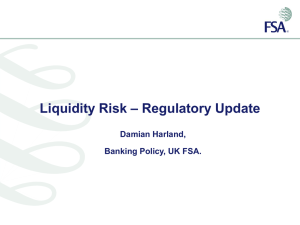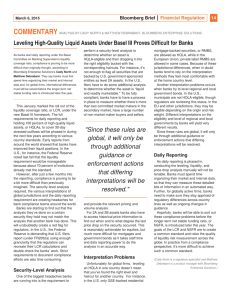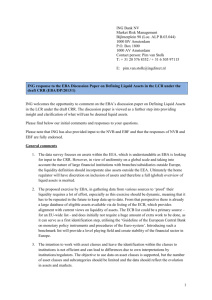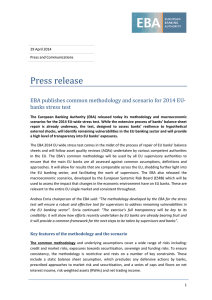Standard Chartered - European Banking Authority
advertisement
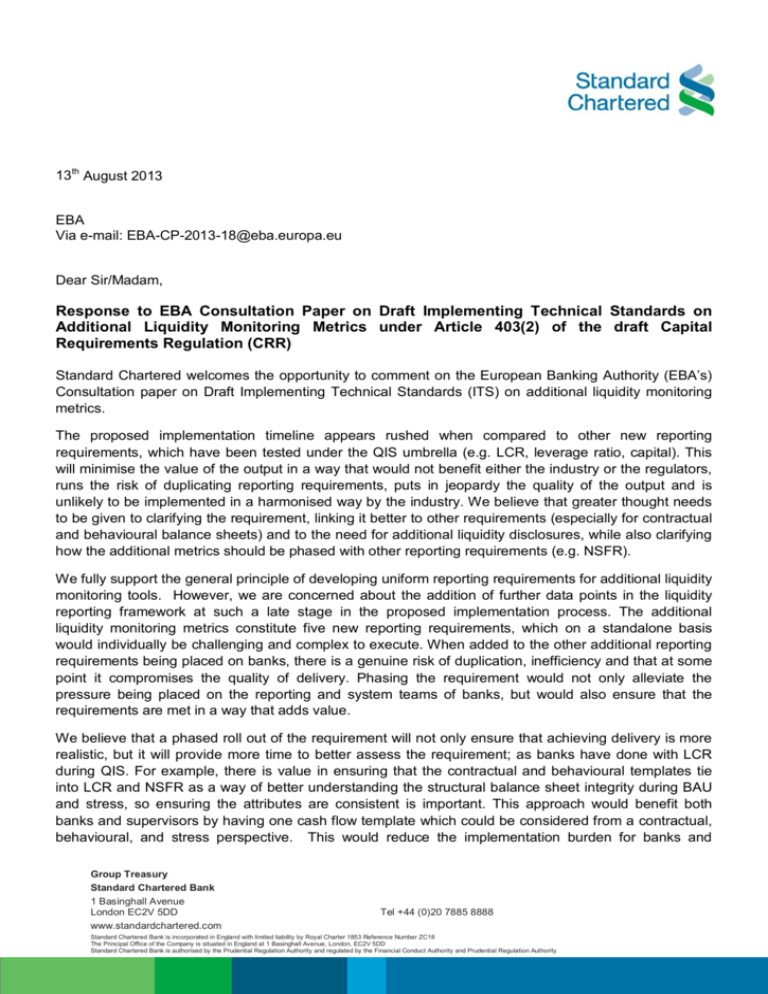
13th August 2013 EBA Via e-mail: EBA-CP-2013-18@eba.europa.eu Dear Sir/Madam, Response to EBA Consultation Paper on Draft Implementing Technical Standards on Additional Liquidity Monitoring Metrics under Article 403(2) of the draft Capital Requirements Regulation (CRR) Standard Chartered welcomes the opportunity to comment on the European Banking Authority (EBA’s) Consultation paper on Draft Implementing Technical Standards (ITS) on additional liquidity monitoring metrics. The proposed implementation timeline appears rushed when compared to other new reporting requirements, which have been tested under the QIS umbrella (e.g. LCR, leverage ratio, capital). This will minimise the value of the output in a way that would not benefit either the industry or the regulators, runs the risk of duplicating reporting requirements, puts in jeopardy the quality of the output and is unlikely to be implemented in a harmonised way by the industry. We believe that greater thought needs to be given to clarifying the requirement, linking it better to other requirements (especially for contractual and behavioural balance sheets) and to the need for additional liquidity disclosures, while also clarifying how the additional metrics should be phased with other reporting requirements (e.g. NSFR). We fully support the general principle of developing uniform reporting requirements for additional liquidity monitoring tools. However, we are concerned about the addition of further data points in the liquidity reporting framework at such a late stage in the proposed implementation process. The additional liquidity monitoring metrics constitute five new reporting requirements, which on a standalone basis would individually be challenging and complex to execute. When added to the other additional reporting requirements being placed on banks, there is a genuine risk of duplication, inefficiency and that at some point it compromises the quality of delivery. Phasing the requirement would not only alleviate the pressure being placed on the reporting and system teams of banks, but would also ensure that the requirements are met in a way that adds value. We believe that a phased roll out of the requirement will not only ensure that achieving delivery is more realistic, but it will provide more time to better assess the requirement; as banks have done with LCR during QIS. For example, there is value in ensuring that the contractual and behavioural templates tie into LCR and NSFR as a way of better understanding the structural balance sheet integrity during BAU and stress, so ensuring the attributes are consistent is important. This approach would benefit both banks and supervisors by having one cash flow template which could be considered from a contractual, behavioural, and stress perspective. This would reduce the implementation burden for banks and Group Treasury Standard Chartered Bank 1 Basinghall Avenue London EC2V 5DD www.standardchartered.com Tel +44 (0)20 7885 8888 Standard Chartered Bank is incorporated in England with limited liability by Royal Charter 1853 Reference Number ZC18 The Principal Office of the Company is situated in England at 1 Basinghall Avenue, London, EC2V 5DD Standard Chartered Bank is authorised by the Prudential Regulation Authority and regulated by the Financial Conduct Authority and Prudential Regulation Authority supervisors as the process of upgrading systems can begin as soon as the LCR data model is finalised, without having to wait for an additional data model to be completed. We believe that banks will have great difficulty in completing these templates alongside LCR and Stable Funding as systems are upgraded during 2014. We have previously written expressing our concern regarding the EBA’s departure from Basel’s QIS template, as this had become the standard that banks were seeking to implement. After approximately two years of running a QIS process, banks still have many areas of uncertainty in terms of definitions as well as systems and control requirements needed to deliver an automated and harmonised solution within the industry. It is hard to envisage that the Additional Liquidity Monitoring templates could be delivered in less time, with no prior QIS equivalent with which to test the process and output, as they are essentially five very different requirements rolled into one standard. RESPONSES TO QUESTIONS Q01: Are the proposed remittance dates feasible? The proposed remittance periods should take into account the industry feedback on the draft ITS on liquidity supervisory reporting requirements (EBA/CP/2012/05), where it was agreed that 15 days would be too short a remittance period while banks are working towards upgrading their reporting systems. Given that the data point model for additional monitoring metrics will not be published until later this year, this leaves no time for banks to implement the requirement and alter their systems to allow for the proposed templates to be completed within 15 days from January 2014. We recognise that in its feedback to responses to the draft ITS the EBA has considered using an interim remittance period of 30 days while banks alter their systems, and that at the Public Hearing on this Consultation Paper the EBA stated that there will be an initial 30 day remittance period. We are in agreement with this approach. Further, the extra burden of additional monitoring templates, divergent from current reporting forms used for QIS and proposed by the EBA, renders the planned implementation date unfeasible. This is exacerbated by the final model not yet being released and the need to allow time for a Q&A process to ensure harmonised reporting from banks. We believe an implementation date of January 2015 is more appropriate to ensure banks are able to set up additional infrastructure in time. Q02: Are the proposed frequency dates feasible? considered? Has the proportionality been adequately In our opinion monthly reporting of these metrics will be adequate once banks have implemented system changes to automatically produce the required reports. In terms of proportionality, we think that these metrics should only be produced on a total currency basis, as regulators will already be able to monitor cross currency risk through material currency LCR reports, while the funding concentration report will show major currency exposures. This will avoid needless duplication. Group Treasury Standard Chartered Bank 1 Basinghall Avenue London EC2V 5DD www.standardchartered.com Tel +44 (0)20 7885 8888 Standard Chartered Bank is incorporated in England with limited liability by Royal Charter 1853 Reference Number ZC18 The Principal Office of the Company is situated in England at 1 Basinghall Avenue, London, EC2V 5DD Standard Chartered Bank is authorised by the Prudential Regulation Authority and regulated by the Financial Conduct Authority and Prudential Regulation Authority The templates should only become a reporting requirement once banks have been given an adequate timeframe to change their systems following publication of final templates and data requirements. Until then it is unfeasible to request the information to be provided monthly on a manual basis in addition to the LCR and Stable Funding templates. Q04: Are the reporting template and instructions sufficiently clear? clarified? Shall some rows/columns be added or deleted? Shall some parts be We believe there is great value in ensuring that the contractual and behavioural templates tie into LCR and NSFR as a way of better understanding the structural balance sheet integrity during BAU and stress. This approach would benefit both banks and supervisors by having one cash flow template which could be considered from a contractual, behavioural, and stress perspective. This would avoid duplication with other balance sheet reporting templates (e.g. COREP/FINREP), lead to greater comparability between banks and greater transparency into each bank’s process of maturity transformation. These are the intentions behind the desire to have improved liquidity disclosures so the two should not be seen as separate. We would reiterate the point that the proposed EBA templates represent a significant departure from the Basel Committee QIS template. BCBS238 specifies that the maturity mismatch template should collect data on the categories required for LCR with only some additional accounting information reported separately. It would be logical to align the LCR and contractual maturity template to provide a single view of the liquidity risk drivers of a bank. The current liquidity reporting regime in the UK aligns the contractual maturity ladder (FSA048) directly to the regulatory stress metric (ILAS ratio). This provides supervisors with a single source for contractual and stress data which would improve comparability without additional system requirements. This would allow for contractual maturity reporting to occur sooner as an automated system can be built around the LCR data model. Our recommendation would be to align the template in annex 1 of the final LCR template to allow crossvalidation and increase reporting efficiency. Supervisors would also benefit by having the contractual and behavioural maturity profile presented in a comparable template to LCR. In our experience even detailed instructions would not be able to cover all circumstances that would arise following implementation. Therefore we would request that time is allowed for a Q&A process prior to implementation. Our initial concern would be that there needs to be more guidance on how to report counterparty exposure for instruments issued through indirect channels, as the first primary buyer may not be the current funding provider. Group Treasury Standard Chartered Bank 1 Basinghall Avenue London EC2V 5DD www.standardchartered.com Tel +44 (0)20 7885 8888 Standard Chartered Bank is incorporated in England with limited liability by Royal Charter 1853 Reference Number ZC18 The Principal Office of the Company is situated in England at 1 Basinghall Avenue, London, EC2V 5DD Standard Chartered Bank is authorised by the Prudential Regulation Authority and regulated by the Financial Conduct Authority and Prudential Regulation Authority Q06: For institutions, could you indicate which type of costs (A1, A2, A3) are you more likely to incur? Could you explain what exactly drives these costs and give us an indication of their expected scale? The cost impact of A1 (“Data collection, record keeping and monitoring”) and A2 (“IT infrastructure”) is significant. While reporting will be required on a monthly basis, banks will be monitoring and storing this data on a daily basis. This will add significant cost so providing clarity on how long data storage is expected by regulators would help reduce excessive data storage for longer periods than required. Regulatory reporting requirements are expanding, but the precise data model requirements have neither been finalised nor published. This makes it very difficult and costly for banks to upgrade their reporting systems in time for the proposed timelines as we are managing multiple projects with interrelated data requirements and purposes, on a standalone basis. Ideally, data requirements should be streamlined as much as possible to avoid duplication and ensure standardised templates are interrelated. Unfortunately, the data models and detailed templates are being drip fed on a periodic basis, making it impossible for banks to validate the interdependencies of their various reporting projects until effectively, the go live date. Banks have already undertaken incremental costs to upgrade systems to meet the new liquidity reporting requirements, adding additional monitoring requirements prior to finalisation of the standard liquidity reporting tools will drive an incremental resource cost burden, but more importantly, risks causing delays and problems in delivering LCR and Stable Funding reporting. We hope you find these comments helpful and look forward to engaging with the EBA on this and other areas of CRDIV/ CRR implementation. Please do not hesitate to contact us if you wish to further discuss any of the above issues. Yours faithfully Pamela Walkden Group Treasurer Group Treasury Standard Chartered Bank 1 Basinghall Avenue London EC2V 5DD www.standardchartered.com Tel +44 (0)20 7885 8888 Standard Chartered Bank is incorporated in England with limited liability by Royal Charter 1853 Reference Number ZC18 The Principal Office of the Company is situated in England at 1 Basinghall Avenue, London, EC2V 5DD Standard Chartered Bank is authorised by the Prudential Regulation Authority and regulated by the Financial Conduct Authority and Prudential Regulation Authority
